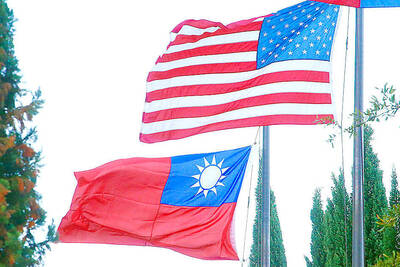The government is considering regulating the use of Chinese social media app Xiaohongshu (小紅書), or Rednote, as the platform could be used by the Chinese Communist Party (CCP) to engage in “united front” campaigns, the Mainland Affairs Council (MAC) said yesterday.
MAC Minister Chiu Chui-cheng (邱垂正) made the remarks at a meeting of the legislature’s Internal Administration Committee, which was scheduled to review proposed amendments to the Act Governing Relations Between the People of the Taiwan Area and the Mainland Area (臺灣地區與大陸地區人民關係條例) and the Act Governing Relations with Hong Kong and Macau (香港澳門關係條例).
Democratic Progressive Party Legislator Huang Jie (黃捷) asked Chiu to comment on statements recently made by Fudan University China Institute director Zhang Weiwei (張維為), who said that Taiwan could be governed easier than Hong Kong if unification is achieved, as young people in Taiwan like Xiaohongshu.

Photo: Reuters
It was the first time a Chinese expert has made a connection between the use of the popular app and unification, Chiu said, adding that the council has suspected the CCP was using the platform to carry out its “united front” campaign.
“If that was the case, people need to be on high alert when they use Xiaohongshu or Douyin (抖音), as the platforms could be used to prepare Taiwanese for unification,” he said.
The council has been urging agencies regulating online affairs to investigate Xiaohongshu, he said, adding that it has identified content on the platform advocating unification by force and destroying the nation’s sovereignty.
“We have been discussing this issue with agencies,” he said. “We think that a crucial moment has come where stipulating laws to regulate the use of Chinese platforms becomes very necessary.”
Chiu called for schools to increase education on media literacy.
Students need to know the problems of using Chinese apps, such as having their personal data exposed to the CCP and receiving propaganda promoting unification, he said.
MAC Deputy Minister Liang Wen-chie (梁文傑) told a news conference that national security officials faced challenges deterring the spread of “united front” propaganda on some online platforms.
“We can only ask national security and cybersecurity agencies to seek the sources of the content and analyze their patterns,” Liang said.
“Due to the lack of a specific law regulating Web site management, officials can be made aware of content and investigate, but they cannot deal with online accounts that produce problematic content,” he said.
“It is like closing all the windows as a typhoon approaches when the house has no roof,” he added.
In other matters, Chiu told the committee that the council has proposed amendments to the cross-strait act based on the 17 national security strategies that President William Lai (賴清德) announced in March in view of China’s increased efforts to infiltrate Taiwan.
The amendments are being reviewed by the Executive Yuan and should be delivered to the Legislative Yuan in one week, he added.

Taiwan is projected to lose a working-age population of about 6.67 million people in two waves of retirement in the coming years, as the nation confronts accelerating demographic decline and a shortage of younger workers to take their place, the Ministry of the Interior said. Taiwan experienced its largest baby boom between 1958 and 1966, when the population grew by 3.78 million, followed by a second surge of 2.89 million between 1976 and 1982, ministry data showed. In 2023, the first of those baby boom generations — those born in the late 1950s and early 1960s — began to enter retirement, triggering

ECONOMIC BOOST: Should the more than 23 million people eligible for the NT$10,000 handouts spend them the same way as in 2023, GDP could rise 0.5 percent, an official said Universal cash handouts of NT$10,000 (US$330) are to be disbursed late next month at the earliest — including to permanent residents and foreign residents married to Taiwanese — pending legislative approval, the Ministry of Finance said yesterday. The Executive Yuan yesterday approved the Special Act for Strengthening Economic, Social and National Security Resilience in Response to International Circumstances (因應國際情勢強化經濟社會及民生國安韌性特別條例). The NT$550 billion special budget includes NT$236 billion for the cash handouts, plus an additional NT$20 billion set aside as reserve funds, expected to be used to support industries. Handouts might begin one month after the bill is promulgated and would be completed within

NO CHANGE: The TRA makes clear that the US does not consider the status of Taiwan to have been determined by WWII-era documents, a former AIT deputy director said The American Institute in Taiwan’s (AIT) comments that World War-II era documents do not determine Taiwan’s political status accurately conveyed the US’ stance, the US Department of State said. An AIT spokesperson on Saturday said that a Chinese official mischaracterized World War II-era documents as stating that Taiwan was ceded to the China. The remarks from the US’ de facto embassy in Taiwan drew criticism from the Ma Ying-jeou Foundation, whose director said the comments put Taiwan in danger. The Chinese-language United Daily News yesterday reported that a US State Department spokesperson confirmed the AIT’s position. They added that the US would continue to

One of two tropical depressions that formed off Taiwan yesterday morning could turn into a moderate typhoon by the weekend, the Central Weather Administration (CWA) said yesterday. Tropical Depression No. 21 formed at 8am about 1,850km off the southeast coast, CWA forecaster Lee Meng-hsuan (李孟軒) said. The weather system is expected to move northwest as it builds momentum, possibly intensifying this weekend into a typhoon, which would be called Mitag, Lee said. The radius of the storm is expected to reach almost 200km, she said. It is forecast to approach the southeast of Taiwan on Monday next week and pass through the Bashi Channel